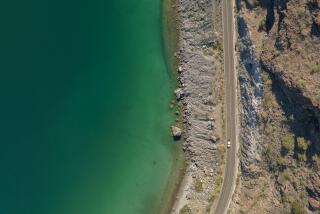Book Review : 2 English Gentlemen Exploring Borneo
- Share via
Into the Heart of Borneo by Redmond O&Hanlon; (Random House: $16.95)
Redmond O&Hanlon; has this to say about the oldest of his and James Fenton’s three guides in the Borneo jungle:
“James and I, in turn, decided that Tuai Rumah Dana, Lord of the House, a Beowulf, or, more accurately, a warrior-king out of Homer, was a great improvement on all our previous headmasters, deans and wardens.”
It is the unmistakable note that British travelers have struck from the time they began, with immense energy and utter disregard of danger and discomfort, to explore the insalubrious quarters of the planet. The corollary to their awesome prowess was a state of mind that held the threat of the exotic down to reassuring schoolboy terms.
O’Hanlon, a natural history writer, and Fenton, a poet, drama critic and former was correspondent, undertook an arduous expedition into some of the least known territory around. The rigors were real and so was the exploratory passion. Both are conveyed. As is the sense that, for all their push through heat, leeches and rapids up toward the headwaters of the Baleh River, they never entirely left the Junior Common Room.
Dropped From the Title
There are times, in fact , when you wonder whether something was dropped from the title. Perhaps it should be: “Hippity Hoppity Into the Heart of Borneo.”
Whimsy and pranks lubricate the adventures and sometimes they and not the adventures seem to be the real point. O’Hanlon, for example, has quite a lot of fun with Fenton’s large bald head, ruminating cozily about its function as a poetry kiln or commenting upon it as spectacle. But then Fenton slips from their boat into a rapid, and the oconography changes from raucous to something different.
“James’s bald head, white and fragile as an owl’s egg, was sweeping round in the whirlpool below, spitting, bobbing up and down in the foaming water, each orbit of the current carrying him within inches of the black rocks at its edge.”
It was nearly a drowning, and along about this point you realize that here are two middle-aged English intellectuals, concealing in their fun and games a quixotic impulse to take on a bit of the nakedness of their jungle-bashing forebears. There is nothing sedentary about their minds. And O’Hanlon’s book, between its often contagious and occasionally less contagious bubbliness, is an engaging and thoughtful musing upon an improbable adventure.
The two friends chose to follow Borneo’s Ranjang and Baleh rivers to the foothills of Mt. Batu Tiban, which had been explored from the east but never, as far as they could discover, from the west. Theri further purpose--since journeys need purposes or else they are tourism--was to catch sight of the two-horned Borneo rhinoceros. They accomplished the first, but not the second.
Their preparations were thorough, and nicely told. For one thing, O’Hanlon read all the explorer and scientific literature about the area. “I was astonished to discover,” he writes, “on being threatened with a two-month exile to the primary jungles of Borneo, just how fast a man can read.” He and Fenton were not simply looking for background; they were looking for survival. And they found it, finally, not in books but in a briefing by the jungle experts of Britain’s commando force, the Special Air Services.
Acquired Supplies, Canoe, Guides
Flying to Kuching on the west coast of Sarawak, the travelers advanced through ever smaller towns and seedier hotels toward Kapit, the outpost that would be their real starting point. At Kapit they acquired supplies, a river canoe with outboard motor and, most important, three guides all belonging to the Iban tribe.
There were no spectacular adventures. There was the incessant battle to keep out the jungle’s voracious organisms and microorganisms and, leeches, mosquitoes, jungle rot and butterflies that collected like midges around any bit of food or waste. There was the slogging through shallows and around rapids. There was overwhelming heat. There was, more generally, the unknown--none of the guides had been upriver.
At tribal settlements along the way, they learned the protocol of visiting and hospitality, and attended all-night feasts of drinking, singing and dancing. Coming upon the Ukit, remote and former head-hunters, the travelers found that the younger set was mainly interested in learning the latest disco steps.
O’Hanlon can write with great delicacy. For all his whimsy, he shows remarkable awareness of the feelings of their Iban companions and of the tribesmen they meet along the way. The real discoveries on this jungle trip are sensibilities. And the author has some thoughtful things to say about jungle life. In their visits ashore, the travelers are continually called upon to treat illness; most of it, infections.
“So this was how the people of the far interior died--exactly as we had been told--of septicemia, of one misjudged cut with a parang in a clearing, of a scratched mosquito bite that became a boil, of a fish-spine in the foot. No wonder the population was so perpetually young, so beautiful,” he writes.
“Perhaps it was not so much the ‘horrible dread of unknown evil’ which ‘hangs like a cloud over savage life, and embitters every pleasure’ but the very sensible dread, in this climate, of every passing accident, of every present microorganism.”
More to Read
Sign up for our Book Club newsletter
Get the latest news, events and more from the Los Angeles Times Book Club, and help us get L.A. reading and talking.
You may occasionally receive promotional content from the Los Angeles Times.






